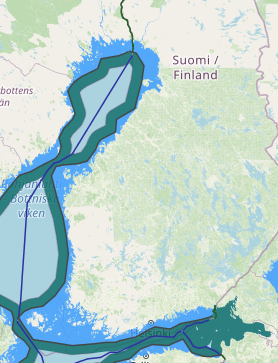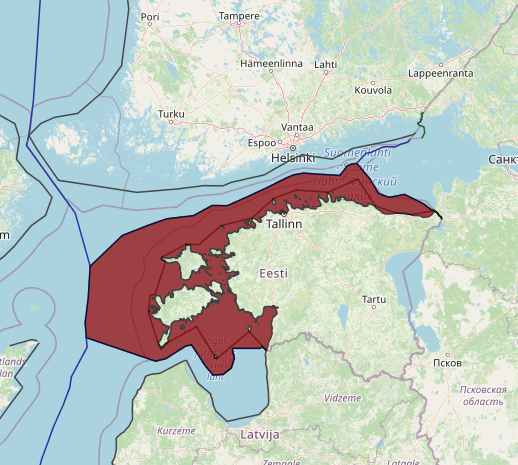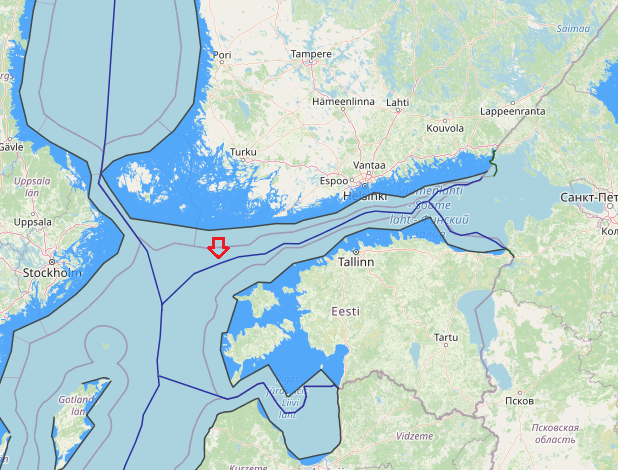Agreement between the Republic of Estonia and the Republic of Finland on the Boundary of the Maritime Zones in the Gulf of Finland and the Northern Baltic Sea was signed in 18 October 1996. In principle, the main aim of the negotiations was not to try to establish a maritime boundary in areas· where no such boundary existed before. In fact, only a very minor part of this agreement could fit such a description. What the Estonia-Finland Agreement did rather was to provide an answer to the much more subtle question about the ·exact legal value to be attributed under international law to the previously concluded maritime boundary agreements, in casu by the former Soviet Union.
For several years the parties side-Stepped the crux of the issue on a provisional basis. Indeed, in 1992 Estonia and Finland started out by concluding an interim agreement. Since no final agreement had yet been reached between the parties at the end of this first period, the latter was extended for another two years. It was clearly stressed that the agreements themselves had not entered into force between the parties, but that the latter had only agreed that the content of these agreements would be applied ad interim. Both countries now have recently terminated the interim agreement by concluding a definite agreement on the subject.
The final outcome seems to indicate that the whole operation can be characterized as a storm in a teacup. Out of the 17 points listed in the agreement, 16 correspond to turning points already established by the former Soviet Union in its relations with Finland. Only the last point is totally new. But this .segment of the line is special, for it covers a maritime area in which the former Soviet Union and Finland had never been able to arrive at a delimitation. In other words, in as far as a maritime boundary line existed at the time of the dissolution of the Soviet Union, that line has now been taken over, point by point, by Estonia and Finland to form the basis of the new agreement.
The only real novelty introduced by the Estonia-Finland Agreement therefore concerns the last point listed in Article 2. This turning point touches upon the most difficult problem of the exact effect to be attributed to the Bogskar island
group belonging to Finland. The latter, which consis1s primarily of two uninhabited rocks with a total area of approximately 4-5 sq. km., is located close to the hypothetical tri-junction point with Sweden. In its relationship with
Sweden, Finland had just arrived at a political compromise in this respect. The present agreement allowed the parties to close the remaining gap around this trijunction somewhat further from the east. Totally in line with a well-established practice in the Baltic Sea, the .agreement finally leaves the two tri-junction points open for later determination with the interested parties.
it is notable the that Nevertheless, all three Baltic States have moved towards accepting the maritime boundaries negotiated on their behalf by the Soviet Union with Finland and Sweden, often through negotiating fresh agreements which serve to reconfirm the course of the relevant maritime boundaries.
A good example of this trend is Estonia’s interim 1992 agreement with Finland on the provisional application of certain treaties concluded between Finland and the former Soviet Union. The 1992 agreement did not confirm the validity of the
Soviet-era treaties. Instead, Estonia and Finland simply agreed to observe their provisions for practical reasons for a specified period of time. Among the treaties covered by the 1992 agreement, which was extended for an additional two years in January 1995, were four maritime boundary accords between Finland and the former USSR. Whilst the 1992 agreement was in effect Estonia and Finland were able to conduct maritime boundary delimitation negotiations leading to the conclusion of a new delimitation treaty on 18 October 1996. The turning points defined in the 1996 agreement are directly based on those previously agreed between Finland and the former Soviet Union, aside from a 30 nm long western extension of the maritime boundary. In keeping with other Baltic sea maritime boundary agreements, the treaty notes, in Article 2, that ‘the starting point of the boundary is that point in the east on which agreement will be reached with the third State concerned’ – that third state being the Russian Federation.
Estonia’s unilateral definition of its territorial sea and EEZ does include qualifying ‘remarks’, however. In respect of Estonia’s territorial sea claim within the Bay of Narva it is noted that as this has not been determined in negotiations with Russia, the boundary ‘may change as a result of these negotiations’. It is similarly stated in relation to the boundary of Estonia’s continental shelf and EEZ ‘near Vaindlo Island in the Gulf of Finland’, that as the boundary has not been
determined in negotiations with the Russian Federation, the boundary ‘may change as a result of the negotiations’.
Once the starting point for the maritime boundary on the coast is determined, the maritime delimitation should not prove particularly problematic. An equidistance line between the parties coasts extends for approximately 65 nm in length initially westwards through the Bay of Narva before turning northwestwards towards the centre of the Gulf of Finland and the potential tripoint with Finland between the Russian island and rock of Ostrov Malyy Tyuters and Ostrov Rodsher and the Estonia islet of Vaindloo Saar. Although relatively small islands or rocks are involved in defining the seaward part of the delimitation, it is unlikely that it could be argued by either side that these should be discounted given that the delimitation predominantly concerns the territorial sea. Furthermore, a delimitation based on equidistance relies on islands and rocks as basepoints on both sides of the line, which therefore tend to balance one another out.











